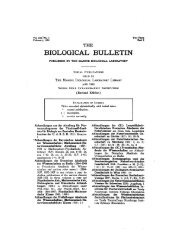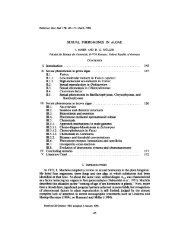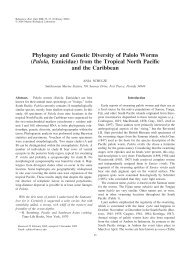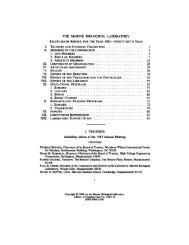NUTRITIONAL STUDIES ON THE AMOEBO-FLAGELLATE ...
NUTRITIONAL STUDIES ON THE AMOEBO-FLAGELLATE ...
NUTRITIONAL STUDIES ON THE AMOEBO-FLAGELLATE ...
Create successful ePaper yourself
Turn your PDF publications into a flip-book with our unique Google optimized e-Paper software.
272 MORGAN M. BRENT<br />
Preparation of bacterial hydrolysates and extracts<br />
It later became evident that certain substances present in the dead bacterial cells<br />
(particularly in Bacillus cereus and B. subtilis) were required for growth of the<br />
amoebae. The B. cereus cells were fractionated in the following manner : Thirty<br />
grams of freshly harvested bacteria were added to an equal weight of alumina and<br />
the aggregate ground by hand with dry ice. One hundred and sixty milliliters of dis<br />
tilled water were added to the crushed cells and the alumina centrifuged out. The<br />
suspended cells were divided among three beakers in equal amounts and enough 1 N<br />
HC1 and 1 N NaOH added separately to two of the containers to make 0.1 N<br />
solutions of acid and base, respectively. The contents of the third beaker were<br />
adjusted to pH 7.00. All three of the vessels were autoclaved for 30 minutes at<br />
15 pounds pressure yielding acid-, alkaline-, and neutral-hydrolyzed fractions. The<br />
contents from each beaker were then divided into two parts:<br />
(a) One-half of the cell suspension from each beaker was subjected to dialysis<br />
through a Visking casing for 28 hours at 4°C. in liter beakers with four changes of<br />
cold distilled water. The dialysates were discarded for the purposes of these<br />
experiments. After dialysis the pH of the three non-dialyzable fractions contain<br />
ing the cell-residues was adjusted to neutrality. The cell-residues were collected<br />
and washed and the non-dialyzable supernatants concentrated to S ml. by boiling.<br />
(b) The pH of the remaining non-dialyzed acid, alkaline and neutral fractions<br />
was also adjusted to neutrality; the cell-residues were collected and the non<br />
dialyzed supernatants concentrated in a similar manner.<br />
All fractions were then re-autoclaved and stored at 4° C.<br />
In later investigations it became necessary to extract the fat-soluble fractions<br />
of the neutral-hydrolyzed non-dialyzed supernatants with various fat solvents.<br />
This was accomplished by shaking each supernatant with an equal volume of<br />
solvent, collecting the latter and repeating the procedure several times. The solvent<br />
was evaporated to dryness and the sediment brought up to the original volume with<br />
distilled water. Before extracting with alcohol or acetone it was first necessary<br />
to evaporate the supernatants to dryness; the insoluble materials were then centri<br />
fuged out.<br />
Vitamins, purines, pyrimidines and amino acids<br />
In experiments requiring special nutrients, mixtures of vitamins, purines,<br />
pyrimidines and amino acids were added in place of certain bacterial fractions. A<br />
stock solution of vitamins was prepared consisting of 50 mg. each of choline@HCI,<br />
folic acid, inositol, nicotinic acid, paramino-benzoic acid, calcium pantothenate,<br />
pyridoxine@ HC1, riboflavine, thiamine' HG and 25 pg of biotin. The purine<br />
pyrimidine mixture consisted of 50 mg. each of adenine sulfate, cytidylic acid,<br />
guanine, thymine, uracil and xanthine. Both of the above mixtures were separately<br />
suspended in 500 ml. of distilled water, filtered through No. 03 Selas filters and<br />
stored at 4°C. The amino acid stock mixture contained 50 mg. each of L-aspara<br />
gine, DL-alanine, L-cystine, L-glutamic acid, DL-methionine and DL-tryptophane.<br />
The above acids were added to 50 ml. of distilled water and autoclaved for 10<br />
minutes at 15 pounds pressure.<br />
@ Non-dialy:able refers to a retained fraction after being subjected to dialysis, as opposed<br />
to non-dialyzed fractions which were not subjected to dialysis.










